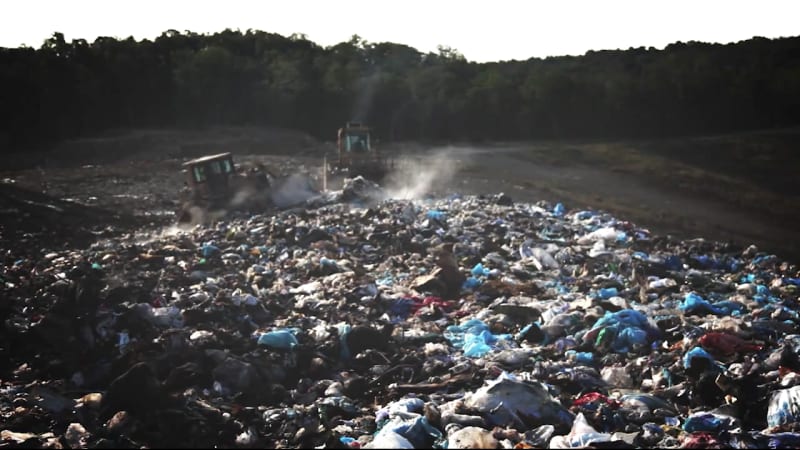Toyota turning landfill gas into hybrid vehicles, indirectly
Chamillionaire certainly wasn't referring to the Toyota Avalon or Camry when he rapped about "ridin' dirty" but maybe he'll change his tune soon. That's because some of the future energy sources for the Kentucky factory that makes those two models will come from gas created from the breakdown of solid waste. So the power behind some of the production at Toyota's largest North American factory will indeed be funky.
Toyota is working with Waste Services of the Bluegrass to build a network of wells at a nearby landfill in order to collect the gases. Construction of the system starts next month and will be finished by early next year. The upshot is that the system will produce one megawatt of electricity per hour, which is the equivalent to the power used by 800 houses.
Last spring, Toyota said it would start producing the Lexus ES at the Kentucky plant after getting almost a $150 million offer from the state. That's because that model is expected to add 50,000 vehicles to the existing production numbers at the plant. And those production numbers are already large, as Toyota makes both the standard and hybrid versions of both the Camry and Avalon there.
Mind you, Toyota's not the first to go this route for factory-energy production. In 2011, General Motors' Orion Assembly Plant started getting about 40 percent of its energy for production of models such as the Chevy Sonic and Buick Verano from methane captured from a landfill nearby. The General estimated at the time that the process would cut the company's energy costs by about $1.1 million a year. Check out Toyota's press release about the Kentucky plant and its future landfill gas below. Show full PR text Landfill Gas to Build Cars and a Greener Community
Partnership between Toyota and local landfill turns garbage into good
March 24, 2014
GEORGETOWN, Ky. (MARCH, 24 2014) - Can a car company be a vehicle for change? Toyota thinks so. The Kentucky plant that manufactures some of the greenest cars on the road, including two hybrid models, will soon be powered in part by green electricity.
Toyota Motor Manufacturing, Kentucky, Inc. has teamed up with Waste Services of the Bluegrass to generate power from local landfill waste, marking the region's first business to business landfill gas to energy initiative. Toyota estimates the locally-generated landfill gas will supply enough power each year for the production of 10,000 vehicles.
How it Works
As solid waste naturally breaks down in a landfill, it creates gas. A network of wells at the landfill will collect and prepare this gas, which will be used to fuel generators for electricity. Underground transmission lines will then carry the electricity to Toyota's manufacturing plant, located a few miles south of the landfill.
What's Next
Construction begins in April, and is expected to be complete by early 2015. Once up and running, the system will generate one megawatt of electricity per hour, or about what it takes to power 800 homes, based on average consumption in the U.S. Additionally, landfill greenhouse gas emissions will be cut by as much as 90 percent, which adds up to better air quality for the local community.
"As a corporate citizen of central Kentucky, we are committed to smarter and better ways of doing business to enhance our community and environment," said Todd Skaggs, CEO of Waste Services of the Bluegrass. "We look forward to being a partner in Toyota's sustainability efforts."
Big Picture Thinking
This isn't Toyota's first non-traditional approach to environmental stewardship. Since 2006, the Kentucky plant has been a "zero-landfill" facility, which means waste generated at the plant gets repurposed instead of getting rejected.
Some of the waste goes into a composter, located on the plant's 1300-acre campus. The compost generated is used to fertilize an on-site garden, which has supplied more than 11,000 pounds of produce, or the weight equivalent of 3.5 Camrys, to a local food bank.
And, that's not all. Toyota is investing in a number of sustainable initiatives, locally and globally. "At Toyota, we believe earth-friendly cars are just the beginning," said Jeff Klocke, facilities and environmental manager. "Together with our community, we think we can contribute to a greener world." Learn more about Toyota's environmental initiatives in the company's latest environmental report: http://www.toyota.com/about/environmentreport2013/index.html.
###
About Toyota Kentucky
Toyota's largest vehicle manufacturing plant in North America, Toyota Motor Manufacturing, Kentucky, Inc. (Toyota Kentucky) produced the first American-made Camry in 1988. Nearly 10 million vehicles have rolled off Toyota's assembly line in Georgetown, where full-time employment is around 7,000 people and investment tops $5.9 billion. In addition to the Camry, America's best-selling car, Toyota Kentucky manufactures the Camry Hybrid, Avalon, Avalon Hybrid and Venza, and four-cylinder and V-6 engines. Beginning late 2015, the plant will begin production of the first U.S.-assembled Lexus, adding 50,000 vehicles to its current annual capacity of 500,000 (engine production capacity: 600,000). For more information about Toyota Kentucky, visit www.toyotaky.com
Source






